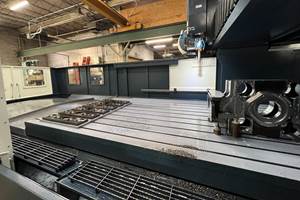Standard Software Addresses Common Machining Challenges
These low-cost VMCs come standard with a number of software features that enable them to compensate for machining’s inherent physical and thermal challenges.
Share






Machine tools fight physics as they cut. Each encounters centrifugal force, thermal expansion and variances in tool load that can adversely affect machining accuracy. According to Hwacheon, shops generally overcome these hurdles either by buying optional tooling, spindle or software components, or by purchasing a costly machine that already has features built-in to address those issues.
However, Hwacheon has made a concerted effort to offer high-end machining capabilities in line with a job shop’s pocketbook. Introduced at IMTS 2010, the Korean builder’s low-cost Vesta line of VMCs comes standard with a number of software features that enable them to compensate for machining’s inherent physical and thermal challenges. These features provide:
•Spindle displacement control—This addresses two conditions: centrifugal force and spindle thermal growth. Centrifugal force at high spindle speeds causes the spindle taper to expand. This tends to pull the toolholder higher up into the spindle, causing variation in a tool’s Z-axis length. Although this spindle taper expansion isn’t managed physically, the Vesta’s Hwacheon Spindle Displacement Control (HSDC) can compensate for Z-axis variation by adjusting the Z-axis servomotor to change the tool’s longitudinal position.
Similarly, thermal growth can adversely affect part accuracy because tools grow longitudinally as spindle temperature increases. This growth varies depending on the rotational speed, tool mass and spindle characteristics. The HSDC compensates for varying tool growth using sensors located along the length of the spindle that continuously monitor spindle temperature. Plus, a cooling jacket installed on the motor both controls heat and keeps the temperature of internal spindle components uniform. This jacket works in conjunction with a fan-cooled chiller unit that cycles according to the spindle temperature.
•Frame displacement control—Thermal growth can also cause a machine’s frame to move, meaning operators must make offsets so that parts are machined to tolerance. This can lead to downtime and potential scrap if there is no automatic means to control these offsets. The Hwacheon Frame Displacement Control (HFDC) receives feedback from temperature sensors strategically placed on each Vesta machine’s casting. Finite Element Analysis design combined with a set of algorithms allows the HFDC to automatically offset the machine’s axis motors to compensate for this thermal growth.
•Efficient Contour Control—It can be difficult to achieve high speed and high precision simultaneously because the precision with which a cutter follows the programmed tool path can vary. The Hwacheon Efficient Contour Control (HECC) effectively manages machining time during chip generation by optimizing the cutting parameters according to the requisite cutting speed and accuracy.
•Tool Load Detection—A dull tool requires higher power to drill a hole or mill a surface. Defects in workpiece material can cause higher tool loading, too. Plus, irregularly shaped workpieces can extend cycle time and reduce tool life because variances in part depth can cause higher loads. These scenarios can result in decreased dimensional accuracy, poor surface finish, tool breakage or even workpiece damage.
The Hwacheon Tool Load Detection (HTLD) feature actively monitors the load on the spindle motor to avoid these conditions. HTLD enables the machine operator to set load thresholds and other parameters that, when exceeded, will trigger an alarm and stop the machine. The machine’s control system also automatically adjusts the feed rate while measuring the load on a spindle motor. It will reduce feed rates when a tool encounters material hard spots or heavier cutting depths and increase the feed rate in soft areas, voids or shallower cutting depths.
Related Content
FANUC Details Robotic Vision, ROBODRILLS and More at IMTS 2024
FANUC’s IMTS 2024 booth includes real-time demonstrations that show the abilities of its equipment, including robots, controllers and machine tools.
Read MoreIn Moldmaking, Mantle Process Addresses Lead Time and Talent Pool
A new process delivered through what looks like a standard machining center promises to streamline machining of injection mold cores and cavities and even answer the declining availability of toolmakers.
Read MoreThree-Axis Bridge Mill Opens New Doors for Construction OEM
Different industries often require different machining priorities, a truism recently demonstrated by Barbco, an OEM of heavy-duty boring equipment that opened up new design possibilities by pivoting toward rigid, less complex machining centers.
Read MoreDN Solutions America Unveils Impressive Chicago Technical Center at IMTS 2024
New tech center is serving as a cutting-edge showroom and a technological hub for advanced machining applications.
Read MoreRead Next
Machine Shop MBA
Making Chips and 91ÊÓƵÍøÕ¾ÎÛ are teaming up for a new podcast series called Machine Shop MBA—designed to help manufacturers measure their success against the industry’s best. Through the lens of the Top Shops benchmarking program, the series explores the KPIs that set high-performing shops apart, from machine utilization and first-pass yield to employee engagement and revenue per employee.
Read MoreAMRs Are Moving Into Manufacturing: 4 Considerations for Implementation
AMRs can provide a flexible, easy-to-use automation platform so long as manufacturers choose a suitable task and prepare their facilities.
Read MoreLast Chance! 2025 Top Shops Benchmarking Survey Still Open Through April 30
Don’t miss out! 91ÊÓƵÍøÕ¾ÎÛ's Top Shops Benchmarking Survey is still open — but not for long. This is your last chance to a receive free, customized benchmarking report that includes actionable feedback across several shopfloor and business metrics.
Read More






















